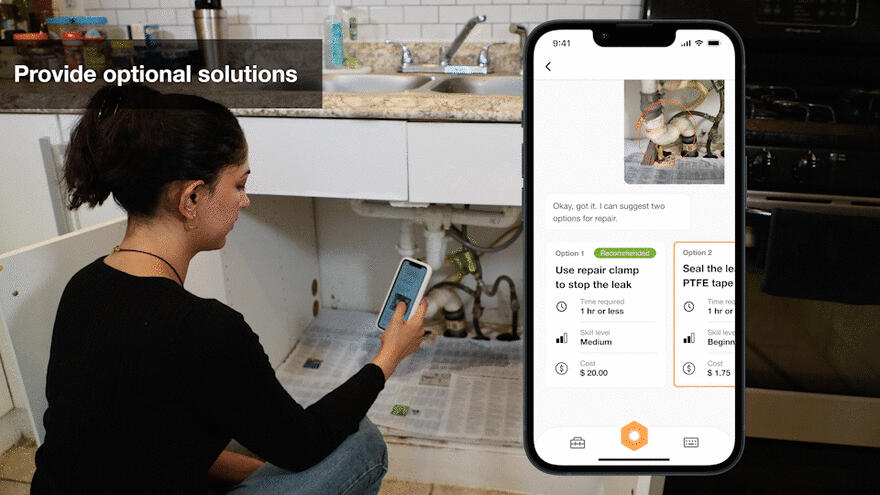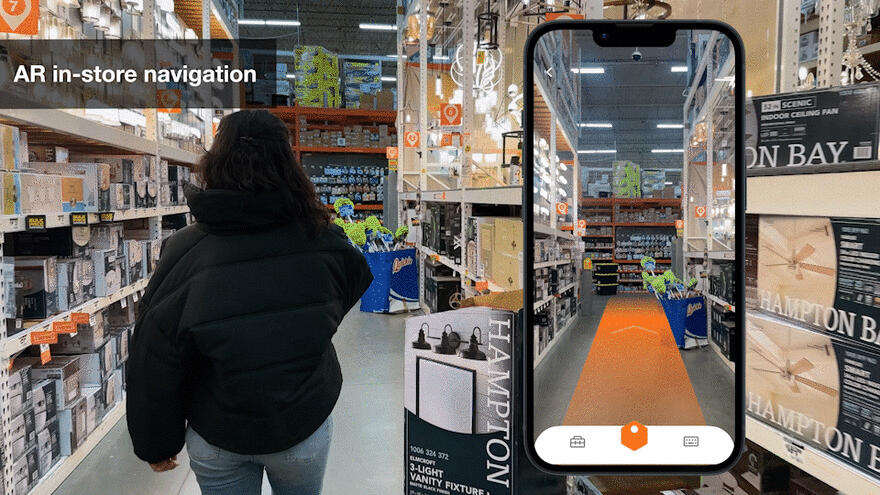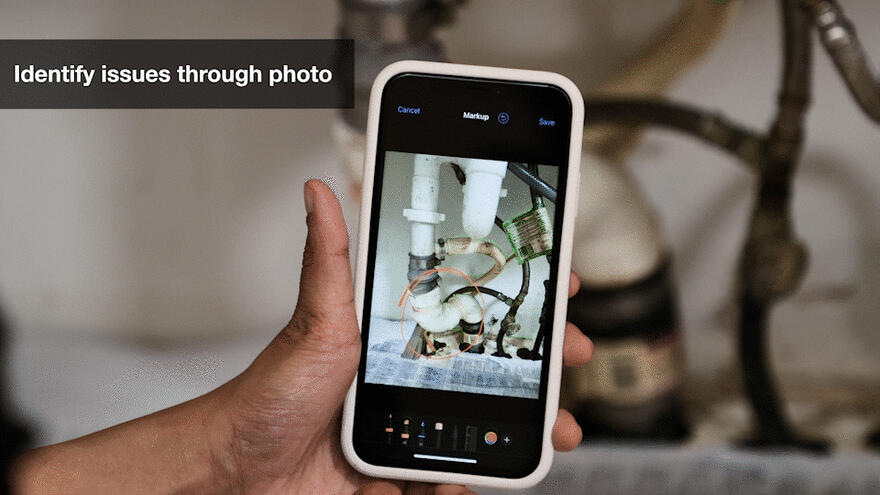CODI

CODI is an innovative Conversational User Interface (CUI) designed to enhance Home Depot's customer experience, especially DIYers, by aiding in home improvement projects.
In the research phase, our team deeply explored Home Depot's brand and client base, focusing on user personas, particularly DIYers, to understand their journeys and challenges both in-store and at home. This insight fueled the design phase, where we pinpointed two key user experiences for CUI enhancement. These are, firstly, aiding users in diagnosing and fixing home issues, and secondly, assisting them in executing home improvement projects.
The essence of CODI lies in its ability to transform Home Depot's vast repository of DIY guides and manuals into an easily accessible, context-rich resource through a smart virtual assistant. This CUI feature is a game-changer, providing users with hands-on guidance in home repair and improvement tasks. Another core aspect of CODI is the integration of Home Depot's existing functionalities with various emerging technologies, such as natural language processing, context awareness, image recognition and analysis, and AR navigation. This integration allows users to conveniently perform a range of tasks within a conversation, including preparing for home improvement, customizing shopping lists, making payments, managing projects, and watch tutorials, etc.

CODI envisions an ecosystem where both customer and employee interactions are streamlined through virtual assistance, promising increased efficiency and satisfaction. This innovation not only elevates the user experience but also sets a new benchmark in the application of CUIs in the retail sector.
Why Home Depot?
Home Depot is known for its vast repository of DIY guides and manuals, in-store expertise, and network of external contractors. As the world's largest home improvement retailer, we saw an opportunity to augment Home Depot's existing resources by making them more easily available to customers through a smart virtual assistant. As the use of AI-powered chatbots and conversational UI increases, there is a greater opportunity to seamlessly engage customers and offer personalized experiences.

Understanding the Home Depot Experience
We conducted immersive, exploratory research at Home Depot to better understand potential pain points in the customer experience, as well as areas of opportunity to augment the current resource ecosystem. We began with field research, interviewing Home Depot employees from four departments. We covertly observed customer interactions and conducted a thorough brand analysis of Home Depot's signature products. Through our initial research, we identified three key personas: the handy-person, the DIYer, and the Outsourcer. Our focus narrowed in on the DIYer, as this persona presented the most potential for a CUI intervention. Next, we conducted customer interviews with individuals who embodied the DIYer persona, which presented us with valuable insights that shaped our design approach. Key findings from these interviews revealed four primary user needs: 1) difficulty locating products and finding associates 2) problem diagnosis and solution 3) project planning and product specification and 4) assistance during projects.

Ideating and Iterating CODI
Based on these insights, we storyboarded two pivotal user journeys where a CUI intervention could significantly improve the customer experience. We presented our findings and storyboards to peers multiple times, iterating after each feedback session.
Concurrently, we considered intangible aspects, such as defining the personality of our CUI—CODI. Parameters like approachability, empowerment, reassurance, and knowledgeability were established as defining traits. The name "CODI" was chosen, a respelling of the gender-neutral name "Cody," signifying helpfulness. Concurrently, we selected a suitable voice for CODI.
The focus then shifted to the visualization of CODI's form, states, and motion. After multiple iterations and peer reviews, the final form was crafted, inspired by the hex nut—a ubiquitous and essential component in various products and machines. Minor adjustments were made to Home Depot's style guide to enhance appeal for our target users without compromising brand recognizability. Subsequently, wireframes and UI screens for the identified journeys were created, and prototypes were mocked up using Figma and Adobe Creative Cloud. The culmination of these efforts was presented in a concept video, chosen as the optimal medium for conveying Codi's narrative.
CUI Design Principles
The team applied three main approaches to designing a conversational user experience for our digital assistant, CODI. These approaches improve the conversational UI (CUI) for DIYers in home improvement by offering a more intuitive and efficient user experience:
- All-in-One Conversation: Simplifies the user's journey by providing essential tools within the conversation, reducing the need to switch between apps or search for information, which is crucial for DIY projects that often require quick access to various tools and information.
- Context-Aware Memory: By understanding the user's skill level and situation, CODI can offer more relevant and supportive responses. This personalization is especially valuable for DIYers who may range from beginners needing extra guidance to experienced individuals looking for advanced tips.
- Interactive Conversation Design: Enables users to tailor the assistant's suggestions to their specific project needs, budgets, and preferences. This flexibility is key in DIY projects where requirements and plans may evolve over time. It also allows for real-time assistance during different stages of a project, enhancing the DIY experience.
Overall, these approaches make CODI an adaptable and helpful assistant for a wide range of DIY home improvement tasks.
Envisioning the Future of Conversational User Interfaces
The integration of Conversational User Interfaces and advanced AI technologies like Large Language Models is revolutionizing user experiences in the DIY sector, notably at Home Depot. These technologies are making complex tasks like home repair more accessible by guiding users through processes with ease, leveraging Home Depot's vast repository of DIY tutorials and instruction manuals. The development of smart virtual assistants, both customer and worker-facing, is enhancing efficiency and satisfaction by providing contextual and customized support. This shift towards multimodal interactions and personalized tutorials based on AI's understanding of individual user needs marks a significant evolution in interaction design. Designers are now exploring new frontiers in multi-modal interactions, creating more intuitive, efficient, and user-friendly platforms like CODI that seamlessly integrate with Home Depot's ecosystem, ultimately transforming the shopping experience and making it significantly more efficient by catering to the high customization demands of users. This innovative approach in CUI design emphasizes not just aesthetics or functionality, but the creation of a dynamic ecosystem tailored to intuitively respond to and anticipate the user's needs, heralding a new era of user interface design that is both flexible and adaptive.